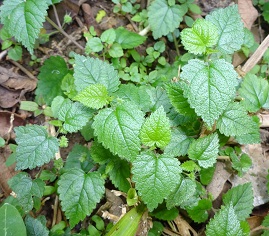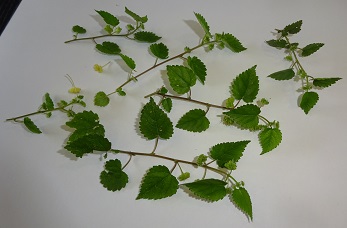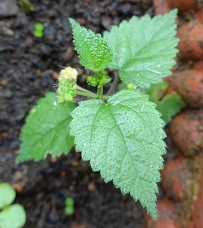| Home | Nature Weekly Index |
14 June 2015 | A New Plant | Fatoua pilosa |
 It was kind of rare to find new plant in urban area around Singapore that were not intentionally planted in pots or open space.
Two weeks back, I was really surprised and delighted to find a new herbaceous plant growing wild on the curb of a carpark area
beside the apartment block that I stayed. The curb was about 30 cm wide and it was always occupied by common weedy plants.
It was kind of rare to find new plant in urban area around Singapore that were not intentionally planted in pots or open space.
Two weeks back, I was really surprised and delighted to find a new herbaceous plant growing wild on the curb of a carpark area
beside the apartment block that I stayed. The curb was about 30 cm wide and it was always occupied by common weedy plants.
 At a first glance, it might look like a
Peperomia pellucida (Common Peperomia) which was common on this little patch
of land. However, this unknown low-lying herbaceous plants with matured heart-shaped leaves of about 2.5 x 1.5 centimetres (cm) was
more wide spreading and had a rougher leaf surface. The overall appearance, especially the fruit bundles, reminded me of
Boerhavia coccinea (Scarlet spiderling). After checking up the pictures, it
was not Boerhavia coccinea. I thought it might be another Boerhavia species or member of the same
family Nyctaginaceae. But after scrolling through many pictures, none came close. There
was also no clue from my reference books. As a last resort, I decided to slowly scroll through
a Taiwan pictorial plant blog, not so much to find the identity of the
plant but to find similar looking plants that could point me to the eventual identity of this unknown plant. Fortunately, it did
provide some clues that help me to crack the codes to some extent. I still have a little doubt on the identity of this plant.
At a first glance, it might look like a
Peperomia pellucida (Common Peperomia) which was common on this little patch
of land. However, this unknown low-lying herbaceous plants with matured heart-shaped leaves of about 2.5 x 1.5 centimetres (cm) was
more wide spreading and had a rougher leaf surface. The overall appearance, especially the fruit bundles, reminded me of
Boerhavia coccinea (Scarlet spiderling). After checking up the pictures, it
was not Boerhavia coccinea. I thought it might be another Boerhavia species or member of the same
family Nyctaginaceae. But after scrolling through many pictures, none came close. There
was also no clue from my reference books. As a last resort, I decided to slowly scroll through
a Taiwan pictorial plant blog, not so much to find the identity of the
plant but to find similar looking plants that could point me to the eventual identity of this unknown plant. Fortunately, it did
provide some clues that help me to crack the codes to some extent. I still have a little doubt on the identity of this plant.

 The placement of Fatoua pilosa in the
family Moraceae seemed rather odd if I solely looked at the overall appearance of the plant.
In my pictorial series, the largest group in this family was the fig, either in tree or climber forms. Comparing to the rest of the
plants in this family in my series, Fatoua pilosa was the smallest and the only herbaceous plant. Its fruits and flowers were
extremely small which made it hard to determine where the similarities with the rest are. The only one in the family that came
slightly close was Morus alba (Mulberry Tree) in term of the shape of its leaves. You can
read more on the yet-to-resolve confusion on this mysterious genus in the
website by Arthur Lee.
The placement of Fatoua pilosa in the
family Moraceae seemed rather odd if I solely looked at the overall appearance of the plant.
In my pictorial series, the largest group in this family was the fig, either in tree or climber forms. Comparing to the rest of the
plants in this family in my series, Fatoua pilosa was the smallest and the only herbaceous plant. Its fruits and flowers were
extremely small which made it hard to determine where the similarities with the rest are. The only one in the family that came
slightly close was Morus alba (Mulberry Tree) in term of the shape of its leaves. You can
read more on the yet-to-resolve confusion on this mysterious genus in the
website by Arthur Lee.
To examine the plant more closely, I cut some branches, with diameter of around 1 millimetre, and brought them home for further investigation last weekend. I took some close-up pictures of the fruits that appeared to be in bundles. There was no flowers in the cut specimens collected. Instead of discarding the specimens, I removed the leaves at the base of the branches and pushed them into the soil in my pot to check out whether it can be propagated by stem cutting. To my surprise, it actually survived. As of today, the original leaves remained green and shiny though no aggressive growth was seen.
According to the Flora of China website, this plant is available in Taiwan, Indonesia, New Guinea, Philippines and Pacific Islands. The current sighting may represent a new record of this plant in Singapore. As to its origin, it seeds probably came along with the soil recently used for tree planting in my area.
Update: 13 January 2016
Today, Jon Boon posted the sighting of this plant in Clementi area in his Facebook site, Our Little Flowers. So far, this post is likely to be the second report on the sighting of this plant in Singapore. As for the population in my area, the wild ones are still growing at the open carpark lots while those stem-cutting ones in my pot are still surviving well.
Update: 31 October 2020
Based on the information from a new article published on 4 August 2020 in the Nature In Singapore journal, the botanical name of this plant should be Fatoua villosa instead.